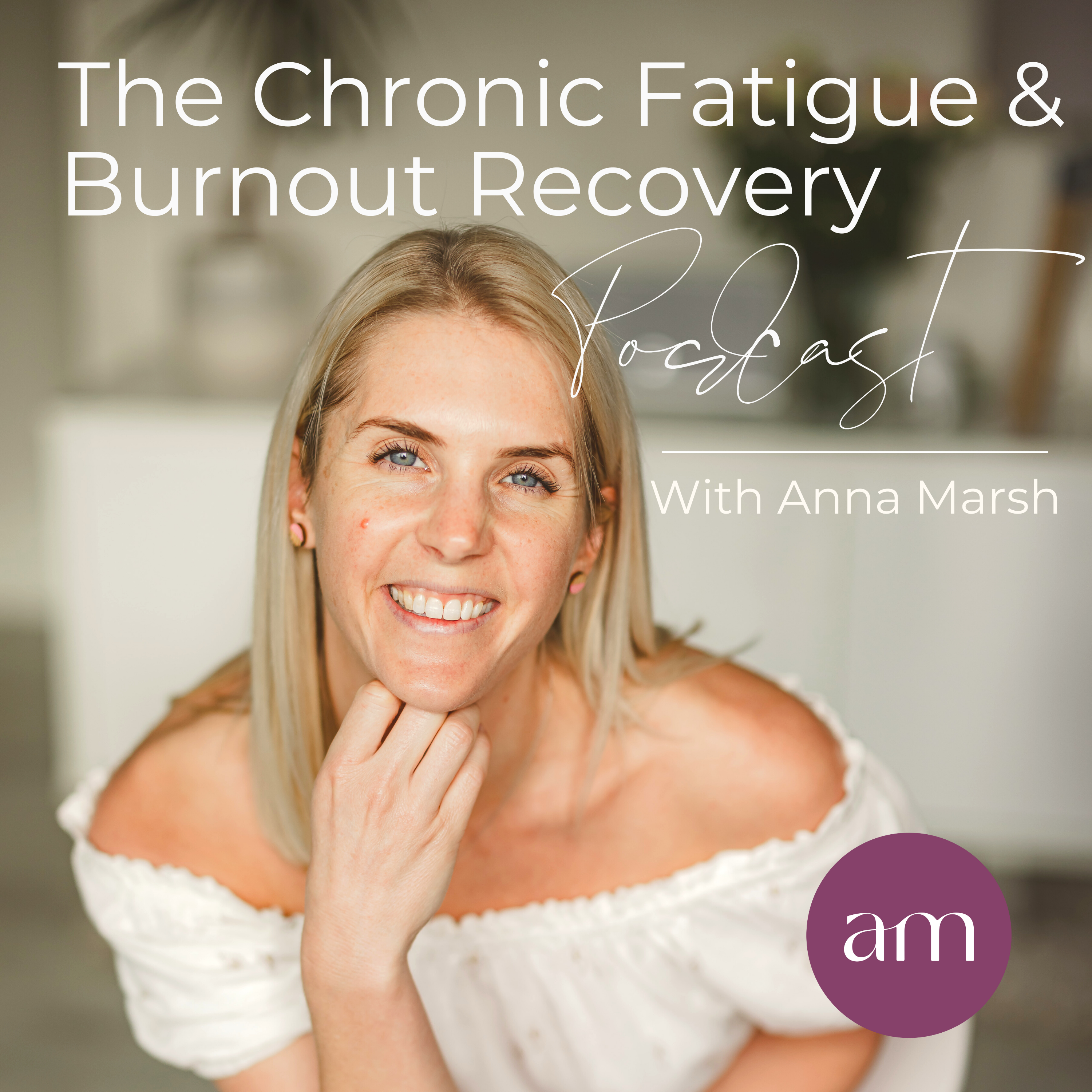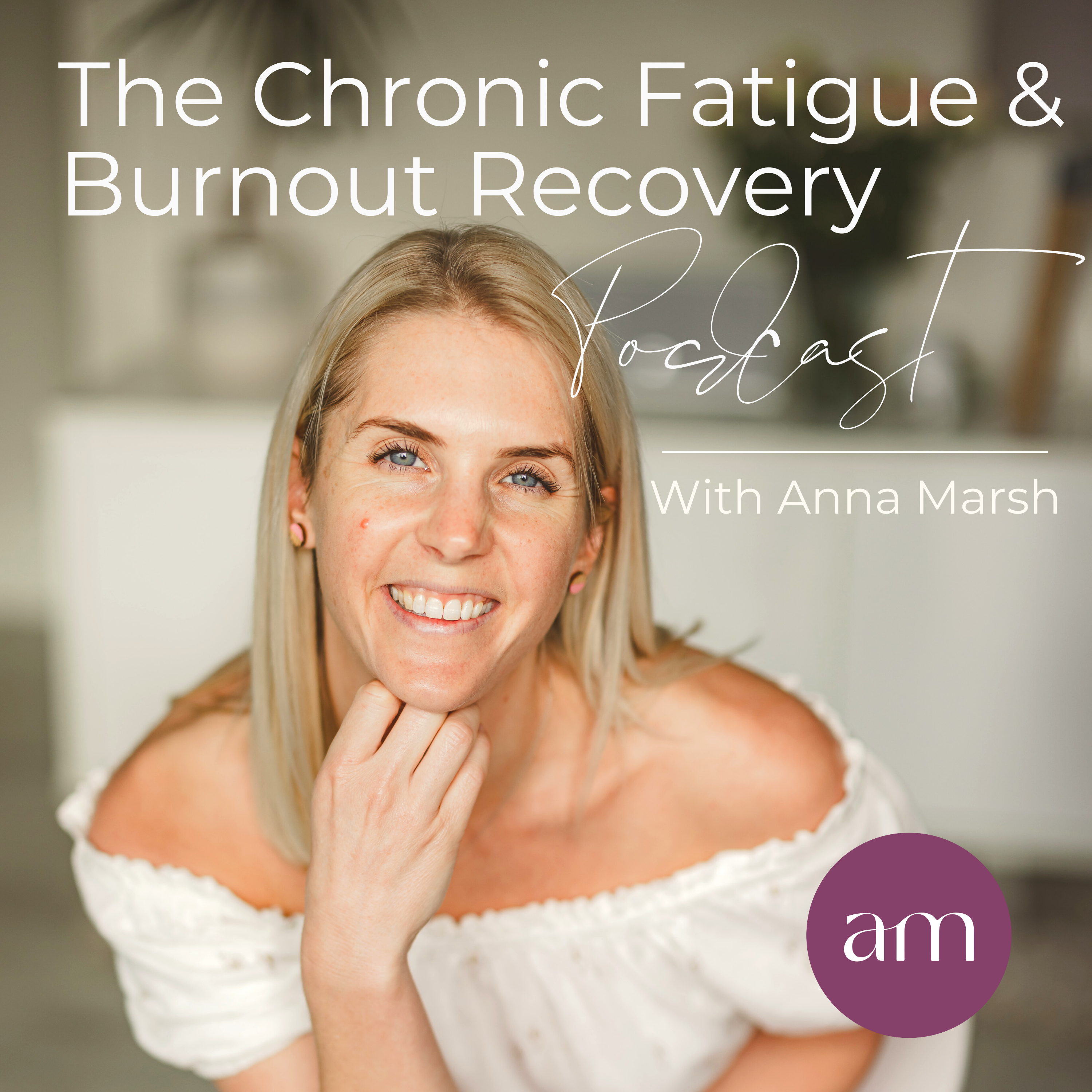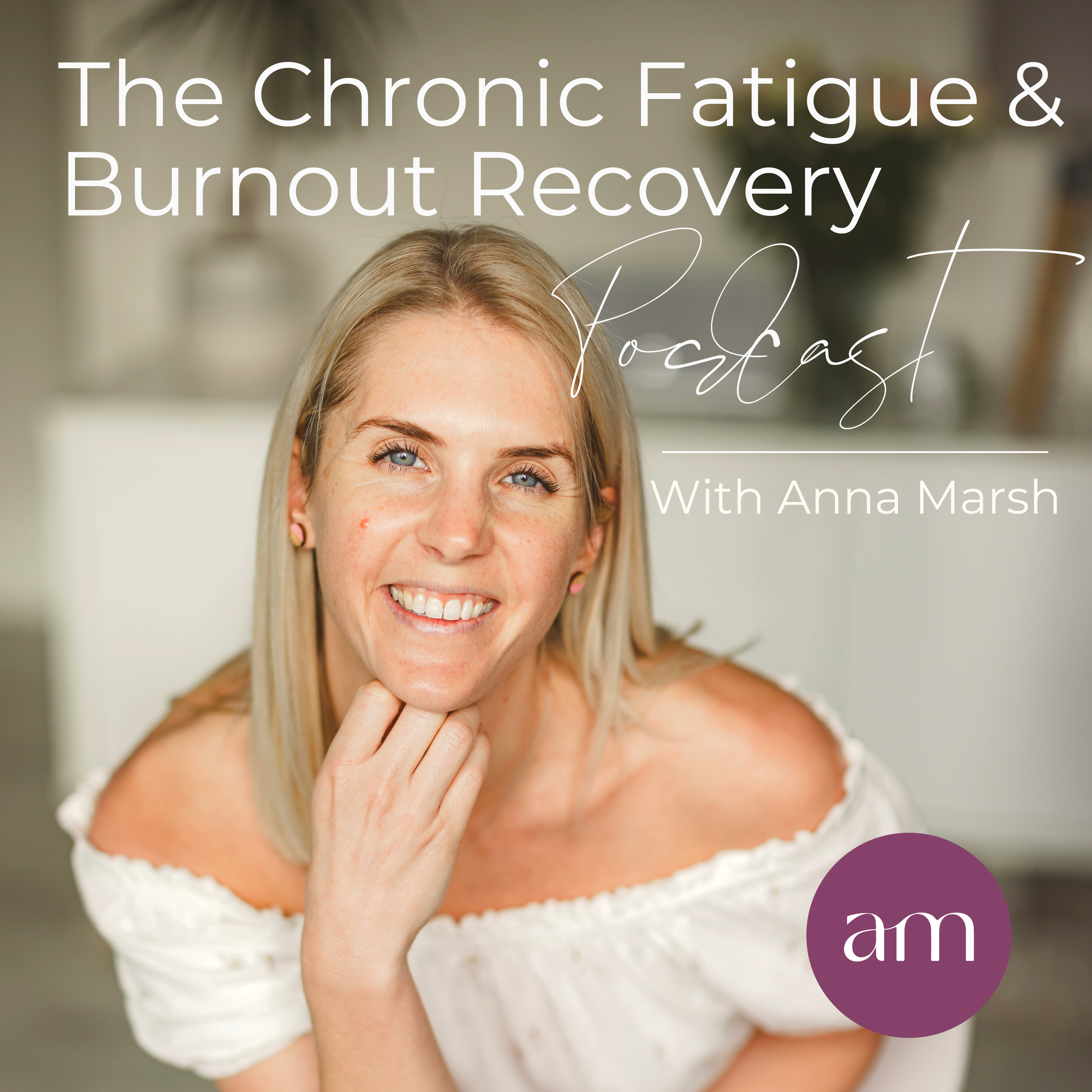The cell danger response (CDR) is the body’s universal and ancient response to threat. It offers a framework from which we can begin to understand what may be happening in those experiencing burnout and fatigue conditions like CFS/ME. Knowing where you are in the CDR can help you to make decisions about what to focus on and where to prioritise your resources in your fatigue recovery journey.
Website: https://annamarsh.co.uk/
Instagram: https://www.instagram.com/anna_marsh_nutrition/
Fatigue Recovery Quiz: https://app.annamarsh.co.uk/quiz
Hello, everyone, and welcome back to the chronic fatigue and burnout recovery podcast. I am your host of functional medicine and nutritional therapist Anna Marsh, and today, we will talk about the cell danger response. The cell danger response is a fantastic framework for understanding or putting your chronic fatigue symptoms into context.
So I came across the cell danger response through the work of Dr. Neil Nathan, who I absolutely love. He wrote the book toxic, which prompted me to test my urine and mycotoxins, and eventually discovered that that was a big factor in the symptoms I was experiencing. But all of that aside, the original creator of the model was Dr. Robert Navio.
I’m not the expert that Dr. Neil Nathan or Dr. Robert Navio is in this area. But this podcast is not about bringing you all the very detailed science. And it’s about helping you understand these frameworks. So you have some context for what could be happening in your body and how to approach the different recovery phases.

As I said already, I love this framework. The purpose of today is to teach it to you, and hopefully, some pennies will drop, some things will fall into place, and you’ll have a little bit more context to support you on your journey. I think one of the hardest things about experiencing a syndrome like chronic fatigue syndrome, when there are many hard things about experiencing a syndrome like chronic fatigue syndrome, is that there’s this lack of understanding because you’re not getting the support from your regular doctor, there are some incredible doctors out there.
But for the most part, many people have these very traumatic stories of not being fully supported and fully understanding what’s going on. Today’s purpose is to give you a little bit more understanding and guide you on your journey. So the cell danger response is an ancient cellular intelligence. It is the body’s or the cells’ universal response to threat. It’s how the cells respond to danger in the body, as the name suggests.
Talking about danger or a threat could be a trigger, like a chemical or toxin exposure, a physical threat, or a biological threat. It’s anything that exceeds the cell’s capacity to maintain homeostasis, which is essentially how the cells and body regulate itself, and ultimately maintain balance in the body. If we are experiencing a trigger, a threat, or a challenge, and it is so challenging that it exceeds the cell’s capacity to cope, then the body will initiate the cell danger response.
It’s important to understand here that the cell danger response is protective. It is ancient body intelligence designed to support you and keep you safe. When we get stuck in the cell danger response or one of the stages of the cell danger response, which I’ll touch on in a moment, we can start to experience a decline in health and then chronic disease.

You may have already heard of the mitochondria if you’re on your fatigue recovery journey. Mitochondria are the little organelles that are in all of our cells. They are how the body makes energy in the form of ATP. Often we refer to the mitochondria as the body’s energy factories, and it is the health, abundance, and function of these mitochondria that allow for good energy production, health, and well-being.
But mitochondria also have another role. Yes, they are energy-producing factories, and we want them to be abundant, healthy, and working well. But they also have another role, which is the role of defense. They are sensing organs and thought organelles. They sense the environment that’s going on in the cell. They sense the environment that’s going on in the body, and they respond appropriately.
So if these mitochondria sense and perceive that is a threat that is a toxin or a trauma or a microbe, then they’ll start to initiate a series of self-protection changes, which are beneficial in the short term. They’re very, very important in the short term. But what can happen in the case of chronic disease is that the body can get stuck in one of the stages of the cell danger response. Unless we can help the body to move through and complete the cell danger response and feel safe again, then we remain stuck and stuck in our illness or symptoms, or whatever our experience of health is. Chronic fatigue might mean that we are stuck in one of the stages of the cell danger response. Therefore, a model for chronic fatigue recovery is helping the cell, mitochondria, or body feel safe again and then also helping it complete the full cycle of all the different stages of the cell danger response.
So what are the stages, and what changes occur in the body at each stage? We have CDR one, cell danger response one, CDR two, and CDR three. CDR one is when the body moves from a state of health to a state of threat. I would call this the high alert stage, and in this stage, the body starts to experience changes in metabolism, the immune system, and even psychological changes or changes in how we see the world.
Here I’ll segue a little bit, and I’ll explain that previously, I’ve done a diploma in psycho neuro immunology, and one of my teachers and mentors, Leo Primbroom, always used to teach that health is about flexibility. We need to be flexible metabolically, which means that we want to be able to use carbohydrates as fuel, use fats as fuel, and be able to continue to fuel the body in the absence of fuels coming in, for example, when we’re fasting. We also need to be immunologically flexible.

That means the immune system should respond when there is an infection or when there is some threat. But the immune system should respond, resolve the threat, and go back to baseline. So there’s flexibility to move between a range of high and low immune activation.
Then finally, we also want to be psychologically flexible, which means that we’re flexible in our thinking. We don’t necessarily have rigidity in our belief systems needing to control everything and struggle when things aren’t just so. I love that the psycho neuro immunology idea of health is about flexibility because it very much overlaps with the cell danger response model. And, when we’re in cell danger response, there is a shutdown, there’s a shutdown in the flexibility of the metabolism, the immune system, and probably our psychology.
In the short term, that’s very, very helpful. But we do want the flexibility to move out of those changes in the long term as we reclaim our health. Finally, just a little note on the psychological aspect. Anyone who’s had the flu knows that their mood is low, they don’t feel good, they can be more emotional or tearful, and they may find it more difficult to think positively. That’s all a psychological response or a psychological representation of what’s going on in the body at that point in time. It can also be protective to a certain degree.
Because if you’re feeling, though, you will not want to overexert yourself if you don’t have motivation. If you feel quite withdrawn and antisocial, you’re not necessarily going to go out and spread your disease, whatever it might be, your infection to other people. So there is a beneficial positive adaptation that happens, which, yes, in the short term, we don’t want it to continue long term.
Circling back to the cell danger response one, what are the specific changes that begin to happen in the body? Well, first of all, the mitochondria can prioritize energy production, away from sort of metabolism away from the brain and cognitive function, and ATP or energy is prioritized towards dealing with the threat to dealing with survival. Or for the immune system to increase its activity to resolve a possible infection.
Again, anyone who’s ever had the flu will know how you feel when you’re sick, your energy is low, your brain is foggy, and even walking up a flight of stairs can leave you breathless, and your muscles are tired and achy. That’s a classic example of the body prioritizing energy to the immune system to thread to survival and away from the metabolism of the muscle tissue and the brain’s cognitive functioning. We’ve all experienced that, but people with chronic disease or a chronic illness or chronic fatigue might feel like that to a certain degree most days then another change that happens is an increase in oxidative stress, which is the body’s oxidative stress is the body’s ability to balance the natural production of oxidative or damaging molecules with antioxidants.
In this case, there’s an increase in oxidative stress, and very often, we’ll hear in disease that oxidative stress is quite prevalent. But it’s really important to understand that in the short term, that oxidative stress is being produced for self-protection. Taking a whole bunch of antioxidants may not be beneficial in the CDR one because the body is producing oxidative stress to help to counterbalance the threat. That’s a change that we may experience.
Then other changes that may occur are a shutdown or reduction in methylation. I’m not going to go into the ins and outs of what methylation is today because that’s probably a whole other podcast in itself. But methylation is a really important biochemical process, which is important for the health of multiple body systems. One of the things that methylation does is produces the powerful antioxidant glutathione.
Given what I’ve just mentioned about the increase in oxidative stress, which is beneficial to the body, in the cell danger response, we don’t necessarily want to purchase a lot of glutathione because that’s going to be an antioxidant. But additionally, another reason for shutting down methylation is that some infections and viruses can hijack the body’s methylation processes and use it to its advantage; hence, it’s advantageous to shut it down in the short term.
Then, the next change that happens is it can be a change in tryptophan metabolism. Tryptophan is one of the body’s amino acids that can be used to make serotonin and melatonin. And if you don’t know, serotonin is our happy hormone, it increases mood, and melatonin is our sleep hormone. So there is a mechanism by which tryptophan can either get prioritized towards serotonin and melatonin production, or it can get shifted in another direction where we make kind of Rumenic and quinolinic acid, which are associated with pain and inflammation.
Again, very beneficial in the short term but may cost our mood and sleep. If we get stuck in the CDR one in the long term, there may be changes in vitamin D metabolism. We have a huge challenge where people are not spending enough time outside, not spending enough time in the sunshine.
Most of my clients have low vitamin D. However, and this also begs the question, is this an outdoor sun exposure problem? Or is this a cell danger response problem, and we sometimes don’t know? We may experience changes in Vitamin B6 metabolism, which can impact histamine production. Histamine can then drive more inflammation, which is beneficial in the short term to help resolve the threat but not long term.
That’s why many people stuck in the cell danger response may be histamine sensitive or have a lot of histamine-like symptoms. That can also be changed in the microbiome and often in functional medicine. You’ll hear people say, you know, health starts in the gut, we work on the gut first, and yes, working on digestive health and digestive function is important.

But if we address digestive health too soon, when there’s still an active threat, this can be counterproductive to what the cell danger response is trying to achieve. Then finally, we get changes in metabolism. When it’s at rest, the immune system is a fat-dominant system. It uses fat for energy at rest.
But an active immune system uses glucose for energy. There is a shift from your fat-burning energy system towards your sugar-burning energy system glycolysis, which can then create a knock-on effect in terms of blood glucose control, and the ability to regulate blood sugar. Remember that all of these things are supposed to be beneficial in the short term.
But in the case of chronic disease or chronic conditions, sometimes this cell can be stuck in the CDR one. That can be because there’s a presence of mold, or the presence of toxins and mold, mycotoxins, maybe heavy metals, it can be because there’s an active infection, or it can be because there’s been a major trauma, or lots of little traumas adding up over time, which has really sent the nervous system into a state of distress, or very often, as I see in my clients, usually a combination of several of these different factors. So really, what we want to do if we suspect that somebody is in the cell danger response one, we have to remove the triggers, we have to be able to calm the system down so that it can feel relatively safer.
I say relatively safer because initially, it will be very difficult to feel 100% safe. But we need to help the body feel safer to continue the recovery process and move through CDR two and CDR three. So there are no tests that will say you’re in CDR one.
Okay, now you’ve moved to CDR three, okay, CDR two is complete, now you’re moving on. So it is very much about trial and error, and some clues can tell us where someone might be. For example, suppose someone is very sensitive to mitochondrial support, or they don’t respond to a lot of the support we might give to the gut or the mitochondria. In that case, we could assume maybe that they’re still in a CDR one, and we need to start thinking about what the trigger is here.
What are the triggers that we need to remove? This is where knowing your root cause comes in can be beneficial. Usually, someone is in a CDR one if interventions make them feel worse or they’re just not responsive. This is why I work the way I do in my practice, which is to offer a continuity of support across six months, given that some people may not be as complex in terms of their case history and what they’re moving through.
But many of my clients have a lot going on, and therefore if they come and see me once, I say, okay, let’s support your gut. For example, let’s try some mitochondria. Let’s try some mitochondria support, and they support the gut, so they do the mitochondria, and nothing happens, or they get worse, they’re never going to come back and see me again.
But, that information, even though it doesn’t feel like progress, it’s telling us something about where we need to go next, which is okay. Likely, there’s still an active trigger here. We need to dig deeper and then address that trigger. I say this for myself, and I say this for any practitioner that you might be working with or considering working with. It’s tough to know. In functional medicine, we build health through taking a client’s history, using testing, noting the client’s symptoms, and then how they respond to the interventions. Sometimes we just head straight out the gates, and somebody gets better straight away, and sometimes we have to mess up and make a few mistakes to get more information so we can choose the right intervention.
That takes time, and that takes being in a supportive clinical relationship. Then we move into CDR two. CDR two is all about rebuilding after CDR one has been completed, and here in this CDR two is where we can start to get a better response to mitochondrial support. We can start getting a better response to gut support, and we may have already started detoxification, opening up those detox and drainage pathways in CDR one.
But now, we can start to become a little bit more aggressive in CDR two, and we may want to think about how we can use nutrition as metabolism changes. So previously, the immune system was very active in that anaerobic sugar-burning metabolism. But now maybe metabolism is shifting and becoming more of an aerobic fat-burning metabolism.
We could start thinking about fasting or a ketogenic diet to encourage autophagy to help with the cleanup process that may be required to help clean up any damage and debris created from CDR one. Then finally, here, we may start to get a little bit more traction with supporting methylation. If we had offered methylation support and CDR one, it probably would have been non-responsive or possibly even made someone feel worse because methylation has shut down.
So now we can bring in methylation support, maybe we can add in antioxidants, and we’re starting to help the body rebuild again, then we transition into CDR three. And CDR three is when we begin rebuilding the communication lines between different body systems. What can happen is this can happen automatically in some people. As we remove the threads, give the system some nourishment, and support the nervous system, then maybe what happens is the body starts to reboot, and those systems naturally start to work a lot better.
That’s what we hope for. But for some people, especially if they’ve been ill for a long time, the body can be habituated to operating in dysfunction. So essentially, dysfunction is their new normal. Therefore, even beneficial interventions can feel like a threat to the body. This is where we want to use nervous system care and support, maybe some brain retraining, if appropriate.
We’re really helping the body feel safe as we make these changes. It might be an opportunity to dig deeper, maybe to do some functional testing. We can look at the hormonal systems, for example, or we can look at what additional nutritional support may be required or what’s going on in the gut, and we can explore and dig a little bit deeper.
This might be a good time to start building the body’s capacity, using hormetic stressors like heat stress, cold stress, fasting, and stress hypoxia, to strengthen the resilience and help the body build its capacity to handle stress as things resolve. Hopefully, from CDR three moving forward, the body can reestablish a sense of health.
This may take longer for some people, and it may take shorter and others. It’s really about knowing what your body needs and giving it that nurturing. Here, we also need to say that there’s an art and a science to healing, the sciences, all the technical stuff. It’s like, okay, what do my test results say? What’s happening here? What mechanisms are working? How do we support those, and what nutrients and dosage?
Then there are the arts, which is just that sense of what the body needs. Because there may be some people who are so desperate to be well, they’ll throw all their resources into their healing, but it’s too much, and that healing is too overwhelming for the nervous system. Again, this is why I work with my clients the way I do over a longer, extended, and supportive timeframe.
We can make those little tweaks and adjustments and continue supporting the nervous system so that it’s a gentle, grounded, and useful approach, which is also embedded in science. That is everything I have to say about the cell danger response today. If you have enjoyed this episode, please let me know. You can reach out on social media. You can share the podcast on your social media, and please remember to leave a review.
Having more reviews helps more people find this podcast, and in doing so, more people can be helped by the information I share. Wishing you a wonderful fatigue recovery day, and I’ll see you in the next episode.

This is a guest expert interview with Zoe McKenzie where we discuss her book which has recently been published. Although the book title suggests...

Shownotes However frustrating they may be, crashes, flares and setbacks are part of the fatigue recovery process. In this episode Anna explains what is...

Shownotes Beverley’s fatigue journey started with a bit of anaemia and glandular fever and ended with a car accident, domestic abuse, a divorce, autoimmunity,...